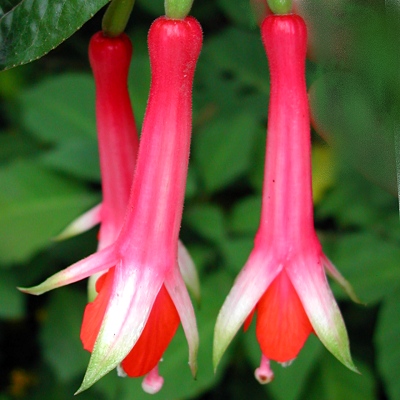| Home |
Strange Wonderful Things Rare and exotic plants |
 |
|---|
Fuchsia denticulata
Please be careful removing your plant from its box
Getting started -- Plan on transferring your plant to a 1-gallon pot and keeping it in a protected spot with no direct sun for the first 2-3 weeks.
Soil -- Your Fuchsia likes loose, well-draining soil that's high in organic matter. Most ordinary potting soils should work. If the soil is heavy & dense, lighten it up using perlite.
Transplanting -- Transplant carefully to avoid damaging the roots. If the plant is hard to slide out, squeeze the bottom edges of the pot while very gently pulling on the stem. If that doesn't work, you may need to carefully cut the pot apart. Water lightly before transplanting if the soil looks dry. Don't pack down the soil after filling it.
Water -- Your Fuchsia likes evenly moist soil, but it doesn't like to be soggy either. Water whenever the soil is about halfway dry down where the roots are. I recommend using a moisture meter probe to monitor the soil moisture. You can buy this at garden and hardware stores for about $4. You simply stick the probe in the soil at the level where the roots are, and water whenever the needle is halfway across the dial. Never let the pot dry out, but don't let it sit in a tray of water either.
A note about water quality -- The tap water in many parts of the country is too alkaline or has harsh chemicals. If you use a water filter, avoid ones that add sodium, like Brita and Pur. When in doubt, use rain water or bottled spring water. Your Fuchsia will greatly appreciate it.
Light -- Your Fuchsia likes tree-filtered sun or morning or late-afternoon sun. Protect it from strong mid-day sun.
Temperature -- The plant prefers moderate temperatures. The ideal temps would be between 55 and 80 during the day, and 45 to 65 at night. In warmer areas, give the plant mid-day shade, and don't place it near a wall where heat can collect. Keep the pot shaded to avoid overheating the roots, and mulch heavily to keep the soil moist. Black pots are not recommended. You may plant it in the ground in mild-winter areas, such as along the Pacific coast. You can test its frost tolerance on rooted cuttings, but until then, protect your plant from all frost.
Humidity -- Fuchsias don't like dry air. Over 50% humidity is recommended. If you grow it indoors and the air is dry, use an ultrasonic room humidifier.
Feeding - Your Fuchsia likes average fertilizing. Feed once a month during periods of active growth, using an ordinary complete vegetable fertilizer at 1/2 the recommended dose. Do not overfeed it. Most potting soil contains fertilizer, which means your plant won't need to be fed for the first month or so. It's normal for a few of the older leaves to turn yellow and drop, however if it's excessive, this is usually a sign that the plant may need more fertilizer, particularly nitrogen.
Repotting - Repot your plant to a larger container whenever the roots start circling around the bottom of the container, or after 3-4 months. The final container size depends on how large you let your plant grow. If you keep it only 3 or 4 feet tall, you can raise it in a 5 gallon pot, but any larger will need a larger pot.
Pests to watch for - whitefly, aphids, scale (little lumps on the stems or leaves), mealy bugs. It is mite-resistant in California, but be on the lookout for possible spider mites (tiny "dots" under the leaves).
If you have any questions, feel free to email me.
Have fun growing it!
Jeff
Strange Wonderful Things
| Home |
Strange Wonderful Things Rare and exotic plants |
|
|---|---|---|
| Entire site Copyright 2003-2025 by Strange Wonderful Things, except as noted | ||

